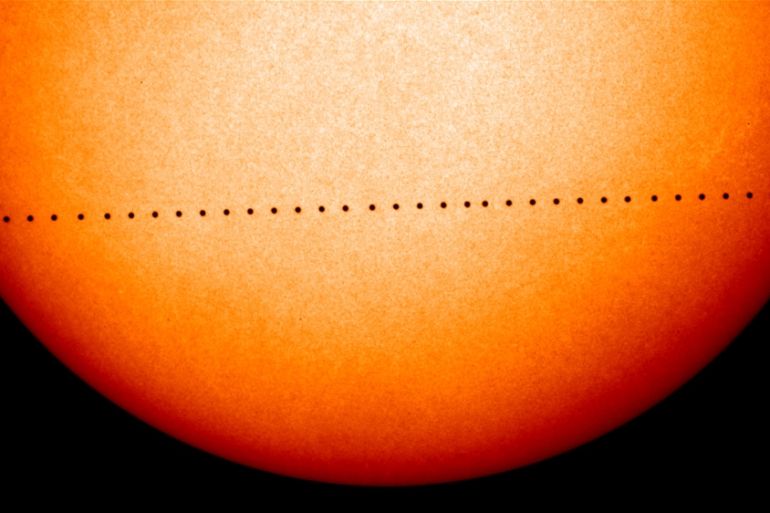Mercury makes rare transit between Earth and the Sun
Passage across the face of the Sun for the first time in 10 years is an opportunity to learn about the solar system.

The planet Mercury is passing directly across the face of the Sun for the first time in 10 years, as it casts a shadow across South America, Africa, Western Europe and the east of North America.
Mercury, which is slightly larger than the Earth’s moon, is too small to see without binoculars or a telescope, and experts warn that looking directly at the Sun during Monday’s event could damage eyes.
Keep reading
list of 4 itemsHong Kong’s first monkey virus case – what do we know about the B virus?
Why will low birthrate in Europe trigger ‘Staggering social change’?
The Max Planck Society must end its unconditional support for Israel
“On no account should anyone try to look directly at the Sun to see Mercury, as this is incredibly dangerous,” Robert Massey of the UK-based Royal Astronomical Society told Al Jazeera.
Many astronomical observatories around the world have opened their doors to view the event, while NASA and the European Space Agency are livestreaming images of the event.
READ MORE: NASA spacecraft smashes into Mercury
Mercury is the closest planet to the Sun and the smallest and fastest-moving one in the solar system. It will take six and a half hours to transit.
Although the event is of limited scientific value, it does provide an opportunity to learn about the solar system.
“Seeing the silhouette of a planet in motion in front of the Sun is a clear demonstration of the solar system in action,” said astronomer Francisco Diego of University College London.
Helps with detecting planets
The transit is also an example of how scientists detect planets in other solar systems, where they are mostly hard to see because they are lost in the glare of the star they circle.
“The Kepler observatory has detected more than 1,000 of these by looking for the small but characteristic dip in brightness as a planet passes directly between its star and the Earth,” said Massey.
Since the last time Mercury transited the Sun, NASA’s Messenger spacecraft spent four years orbiting around the planet, before being deliberately crashed into its surface last year.
The mission revealed Mercury’s moon-like surface in unprecedented detail, scarred by the collision of asteroids and meteorites.
It also mapped ancient lava flows and discovered what is believed to be ice at the planet’s poles.
“Planets in our own solar system are particularly helpful, because we can see them close up and learn vastly more about their similarities and differences than is possible for more distant planets,” Andrew Pontzen, a lecturer at University College London, told Al Jazeera.
Mercury will next pass directly across the face of the Sun in 2019, and then not until 2032.
Follow Tarek Bazley on Twitter: @TarekBazley